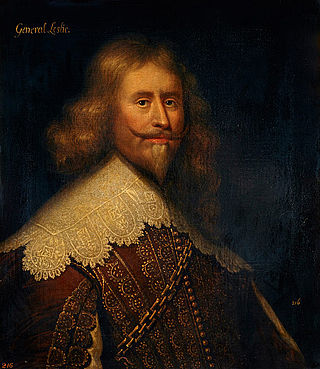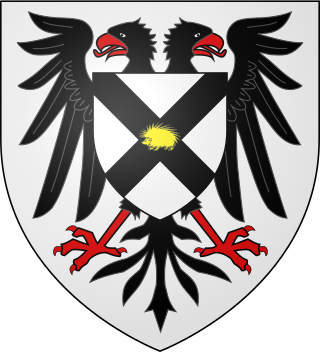Life
He was the eldest son of Alexander Lindsay, 1st Lord Spynie from his wife Jean Lyon. He was still a minor at the time of his father's murder in 1607. In year 1609, the trial of his father's murderer was not proceeded with on account of the absence of a prosecutor. A protest was made on his behalf and of the other children, how their ultimate right of prosecution should not be invalidated. However, after Spynie came of age, he agreed to waive his right of prosecution, when Lindsay of Edzell, the murderer, affirmed on oath that the slaughter was accidental. He paid a sum of eight thousand merks and transferred the lands of Garlobank, Perthshire to him and his sister. On 7 March 1617, Edzell obtained a remission for the slaughter under the great seal. [1]
Spynie was one of the Scottish lords who attended the funeral of James VI and I in Westminster Abbey in 1625. On 2 June 1626, he became commander-in-chief in Scotland for life. Having raised a regiment of three thousand foot for King Christian IV of Denmark-Norway, he served with distinction in both Denmark and Germany. Christian made him Governor General of the eastern Danish provinces of Skåne, Halland and Blekinge. [2] In 1628 his regiment fought at the siege of Stralsund alongside the regiment of Donald Mackay, Lord Reay. The Scots and their allies in the garrison were eventually relieved by Sir Alexander Leslie who was made governor of the city. [3] Lord Spynie and his regiment were thereafter recalled to Skåne while Mackay's was recalled to Copenhagen leaving Leslie and his troops in command of the city.
After his return to Scotland, his appointment as commander-in-chief was confirmed on 28 June 1633. [1]
In the dispute with the Covenanters, Spynie supported the king Charles I of Great Britain. He joined Montrose at Perth after the battle of Tippermuir in September 1644. On 14th, he was with him as he entered Aberdeen. However, two days afterwards, Montrose vacated the city for he was taken as a prisoner and sent south to Edinburgh. [1]
Spynie died in March 1646. [1]
Family
Spynie was first married to Joanna Douglas, and on the second time to Lady Margaret Hay, only daughter of George Hay, 1st Earl of Kinnoull. On his first wife, Spynie had no issue. On his second, he had two sons, Alexander, master of Kinnoul, and George, who succeeded him as third lord—and two daughters. Margaret, married to William Fullarton of Fullarton, and Anne, who died unmarried. [1]

Alexander Leslie, 1st Earl of Leven was a Scottish military officer and peer. Born illegitimate and raised as a foster child, he subsequently advanced to the rank of field marshal in Swedish Army, and in Scotland became Lord General in command of the Army of the Covenanters, a privy councillor, captain of Edinburgh Castle, Lord Balgonie and Earl of Leven. In England he commanded the Army of the Solemn League and Covenant and was senior commander of the Army of Both Kingdoms (1642–1647). Leslie served in the Thirty Years' War, the Bishops' Wars, and most of the English Civil War, fighting primarily in the First English Civil War. Leslie would live a long life, dying roughly at the age of 80 or 81.

James King, 1st Lord Eythin (1589–1652) was a Scottish soldier, who served in the Swedish army, and who later supported King Charles I in the Bishops' Wars, and then later in the English Civil War.
Robert Monro, was a famous Scottish General, from the Clan Munro of Ross-shire, Scotland. He held command in the Swedish army under Gustavus Adolphus during Thirty Years' War. He also fought for the Scottish Covenanters during the Bishop's Wars in Scotland and commanded the Scottish Covenanter army during the Irish Confederate Wars. He was the author of a diary recounting his military experiences during the Thirty Years' War, published as Monro, His Expedition With the Worthy Scots Regiment Called Mac-Keys.
Lord Spynie is a title in the Peerage of Scotland. It was created on 4 November 1590 for Sir Alexander Lindsay, younger son of David Lindsay, 10th Earl of Crawford. The title became dormant on the death of the third Lord in 1671.
Sir David Carnegie, 1st Earl of Southesk, 1st Baron Carnegie of Kinnaird, 1st Baron Carnegie, of Kinnaird and Leuchards (1575–1658) was a Scottish nobleman. He was a member of the Privy Council of Scotland and held the office of Lord of Session. He was created an earl in 1633.

Clan Lindsay is a Scottish clan of the Scottish Lowlands.
Alexander or Alex Lindsay may refer to:
Colonel Robert Munro of Foulis, also known as the Black Baron, was traditionally the 18th Baron of Foulis in Scotland. He was a soldier of fortune, who served in Germany under the banners of Gustavus Adolphus, king of Sweden. It is not certain how he got his epithet of the 'Black Baron', but quite possibly it was from the colour of his hair rather than any perceived martial ferocity. Although this Robert Munro is traditionally 18th Baron and 21st overall chief of the Clan Munro, he is only the 11th Munro chief that can be proved by contemporary evidence.

The siege of Stralsund was a siege laid on Stralsund by Albrecht von Wallenstein's Imperial Army during the Thirty Years' War, from 13 May 1628 to 4 August 1628. Stralsund was aided by Denmark and Sweden, with considerable Scottish participation. The lifting of the siege ended Wallenstein's series of victories, and contributed to his downfall. The Swedish garrison in Stralsund was the first on German soil in history. The battle marked the de facto entrance of Sweden into the war.
John Graham, 3rd Earl of Montrose was a Scottish peer and Chancellor of the University of St Andrews from 1599 to 1604. He was Lord High Commissioner to the Parliament of Scotland, from 1605 to 1606.
Alexander Seaton or Seton was a Scottish soldier in Danish service during the Thirty Years' War. He briefly served as a governor in the Battle of Stralsund and as an admiral in the Torstenson War.
David Lindsay, 11th Earl of Crawford (1547?–1607) was a Scottish nobleman and privy councilor.
Sir David Lindsay of Edzell, Lord Edzell (1551?–1610) was a Scottish judge.

Robert Maxwell, 1st Earl of Nithsdale, was a Scottish nobleman. He succeeded his brother as 10th Lord Maxwell in 1613, and was created Earl of Nithsdale in 1620. General of Scots in Danish-Norwegian service during the Thirty Years' War. A loyal supporter of Charles I and a prominent Catholic, he lost his titles and estates in 1645, dying on the Isle of Man in 1646.

There was a complicated involvement between Scotland and the Thirty Years' War of 1618–1648. Scotland and the Scots were heavily entangled in both the diplomatic and military events which centred on the Holy Roman Empire. There were a number of reasons for this participation.

Alexander Lindsay, 1st Lord Spynie was a Scottish nobleman. His death is the subject of the ballad Lord Spynie.
George Lindsay, 3rd Lord Spynie was a Scottish nobleman.
Sir Walter Lindsay of Balgavie was a Scottish Roman Catholic intriguer.
David Lindsay, 10th Earl of Crawford (1527-1574) was a Scottish landowner.
Thomas Mackenzie of Pluscarden, also known as of Pluscardine was a Scottish soldier and member of parliament of the 17th century. He was a member of the Clan Mackenzie, a Scottish clan of the Scottish Highlands.
![]() This article incorporates text from a publication now in the public domain : Lee, Sidney, ed. (1893). "Lindsay, Alexander (d.1646)". Dictionary of National Biography . Vol. 33. London: Smith, Elder & Co.
This article incorporates text from a publication now in the public domain : Lee, Sidney, ed. (1893). "Lindsay, Alexander (d.1646)". Dictionary of National Biography . Vol. 33. London: Smith, Elder & Co.





